The 61st edition of CicLAvia is upon us this Sunday (as you may or not know it was supposed to be the 62nd, but here we are). Barring any extreme raids from El Hielo to spoil the fun, you can expect some hot (well, partly-cloudy in the mid-70s at least) fun in the Summertime during this CicLA.
This Sunday’s 6.8-mile CicLAvia route with a terminus at Venice Beach may or may not seem awfully familiar – because we had a route very similar to it just last year, on April 21, 2024, although that route was primarily on Venice Boulevard with nary a turn until Venice proper.
The Venice Beach-bound CicLAvias began on April 21, 2013 with an epic, ambitious 15-mile CicLAvia To The Sea route. But this route is mostly fashioned after the March 26, 2017 (Culver City Meets Venice) route that covered exactly the same territory, save for extending the route a bit father east this time around.
As usual — Happy CicLAvia, Go Dodgers, Go Galaxy or LAFC and see you or not see you on the streets!
Oh yeah, if you found this Epic CicLAvia Tour guide useful and visit any of these sites, please add the #EpicCicLAviaTour hashtag to any social media post that includes it. The Militant will be glad to re-tweet!
And if you appreciate The Militant’s work, kick him a little love via PayPal! He *hates* asking for money, but you know how it is these days…A Militant’s gotta pay his bills! He sacrifices a lot of his time to do this, so your support is much appreciated!
To support The Militant Angeleno: https://www.paypal.com/donate/?hosted_button_id=K5XC5AM9G33K8
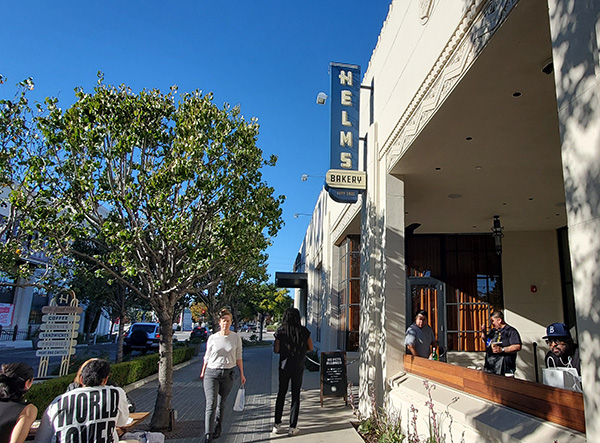
1. Helms Bakery
1931
8758 Venice Blvd, Los Angeles
From 1931 to 1969, Angelenos knew their bread, and it came from blue-and-yellow delivery trucks from the legendary Helms Bakery, founded at this site, with eventual satellite bakeries in Montebello and San Bernardino. It was the official bread of the 1932 Olympic Games here in Los Angeles, and the bread was so renowned, it was provided to the U.S. Olympic teams in subsequent Olympiads. It was even the first bread eaten on The Moon, as part of the Apollo 11 astronauts’ food rations. But you couldn’t buy the bread in any store, it was only from their delivery trucks (yes, the food truck craze is not new round here) with their tell-tale “TOOT! TOOT!” whistle. Ultimately, after an era where people bought food from delivery trucks, the Helms brand succumbed to the rise of the supermarket. This building and its trademark neon sign stand, adaptively reused, as a testament to its history and impact on Southern California. But everything old is new again, and like the legend of the Phoenix, The Helms Bakery (dough) rises again. After over a decade of seemingly empty promises, Helms Bakery 2.0 opened in November 2024. Unlike the classic delivery trucks of yesteryear, the 21st century incarnation of Helms is a brick-and-mortar establishment uhh…helmed by chef Sang Yoon (of Father’s Office fame) featuring a sandwich/salad deli, pastries and a cafe with an outdoor dining area. Helms awaits you this Sunday – but bring your plastic, as Helms 2.0 is a cash-free establishment (and will make you insert/tap your card multiple times if you purchase items from the different sections of the bakery).
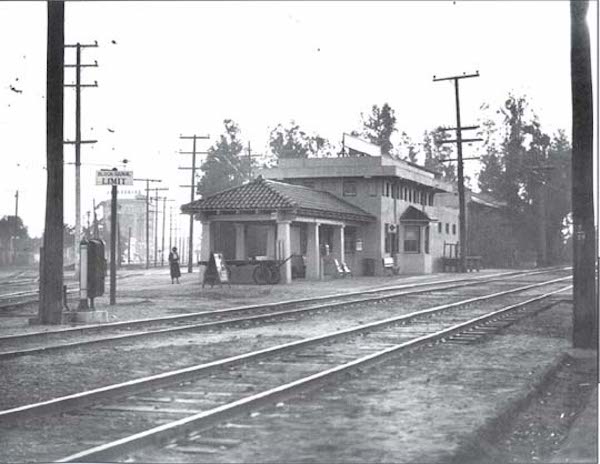
2. Culver City Metro (E) Line Station/Site of Culver Junction
2012
Venice and National boulevards, Culver City
You may or may not have arrived at CicLAvia via the Metro (E) Line, which is the modern reincarnation of the Pacific Electric Santa Monica Air Line. Not only can you experience Los Angeles’ transportation present, but you’re also in the clear presence of its past — this area was also the site of Culver Junction, where not one, not two, but three Pacific Electric Red Car lines converged, going to Santa Monica, Venice and Redondo Beach. TIP: Make sure you buy a Day Pass or that your TAP card is well-loaded before CicLAvia, so you don’t have to queue at the ticket machines! The Militant says “You’re Welcome.”
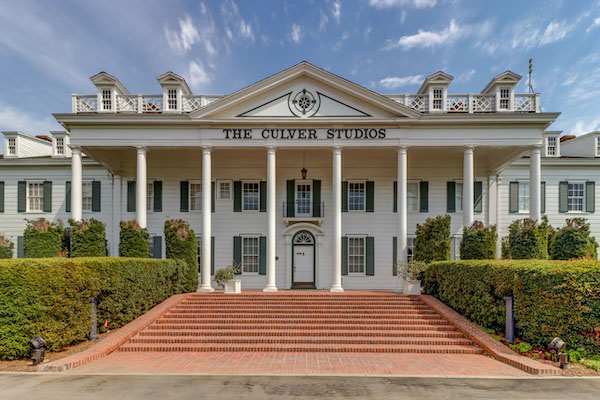
3. Ince Boulevard/The Culver Studios
1918
Ince Blvd & Washington Ave, Culver City
As you make your first turn going westbound on the CicLAvia route, take note of the street name: Ince.
If you know your Culver City history, the town was a planned community built by landowner Harry H. Culver, a veteran of the Spanish-American War who worked for SFV pioneer Isaac N. Van Nuys and purchased a large section of the old Rancho La Ballona. In 1913 he established the town and filmmaker Thomas Ince moved his operation here from Pacific Palisades (via his Triangle Studios down the street — more on this later…) and bought this section of land from Culver himself to establish the Ince Studio, which featured a large mansion fashioned after George Washington’s Mt. Vernon residence, that remains in full view today. Ince’s studio was sold to Cecil B. DeMille after his mysterious death and had changed hands and names over the years, finally adopting its current name of The Culver Studios in 1970. Legendary Hollywood films were shot this studio, including Gone With The Wind, King Kong, E.T. and The Matrix.
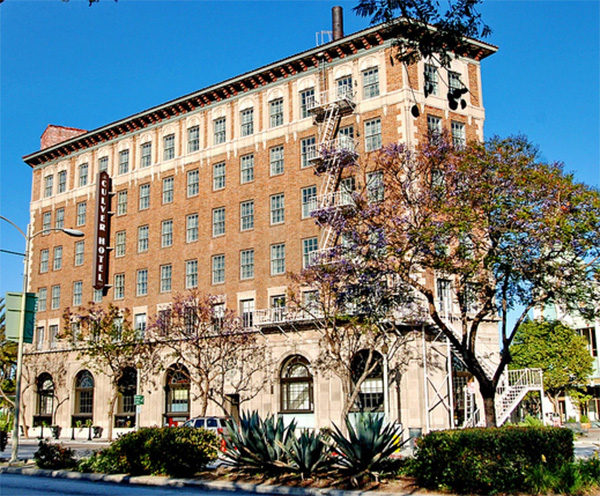
4. The Culver Hotel
1924
9400 Culver Blvd, Culver City
This 6-story triangular building, originally named Hotel Hunt, opened over a century ago as Culver City’s first skyscraper (it was the tallest building between Downtown Los Angeles and Venice) and housed Harry Culver’s personal office on the second floor. Numerous Hollywood stars have stayed here, such as Joan Crawford, Clark Gable, Greta Garbo and Ronald Reagan, and most notably the little people actors who played the Munchkins in The Wizard of Oz during its filming down the street. Actor John Wayne was one of the later owners, and it was fully restored in the 1990s.
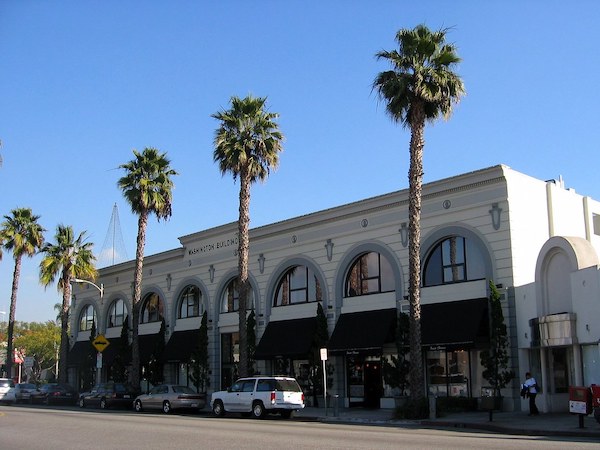
5. The Washington Building
1927
9718 W. Washington Blvd, Culver City
Culver City’s other 1920s-era triangular building is just down the street from The Culver Hotel. Built by Charles E. Lindblade, a business associate of Harry Culver who also bears a city street name of his own, this Beaux Arts-style building was designed by Arthur D. Scholz and Orville L. Clark. As it is today, the building housed numerous retail and office businesses over the years, including the Culver City post office, the MGM Studios Fan Club and Lindblade’s real estate company.
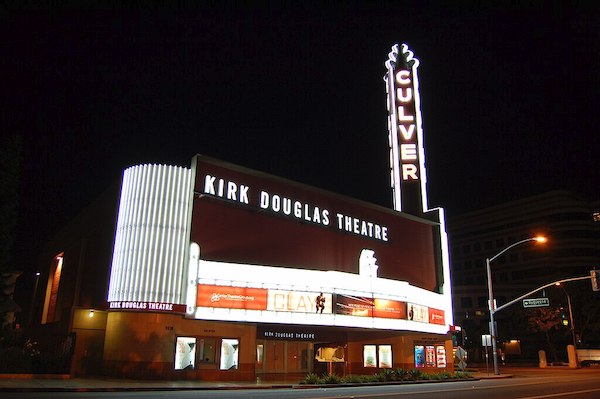
6. Kirk Douglas Theatre/Culver Theatre
1946
9820 W Washington Blvd, Culver City
Built in 1946 as The Culver Theatre, a 1,100-seat Streamline Moderne cinema designed by Karl G. Moeller that screened 20th Century Fox films as part of the Fox West Coast Theatres chain.
It was later operated by the National General and Mann Pictures chains, and finally as an independent theatre. It was split into three screens circa 1970s, and closed in 1989. In 1994, it suffered damage from the 1994 Northridge Earthquake and underwent a major $8 million renovation later in the ’90s, re-opening in 2004 as The Kirk Douglas Theatre (with Spartacus himself as a the major contributor in the renovation), operated by Center Theatre Group. It currently features two stages, one seating about 300 and a smaller stage seating around 100.
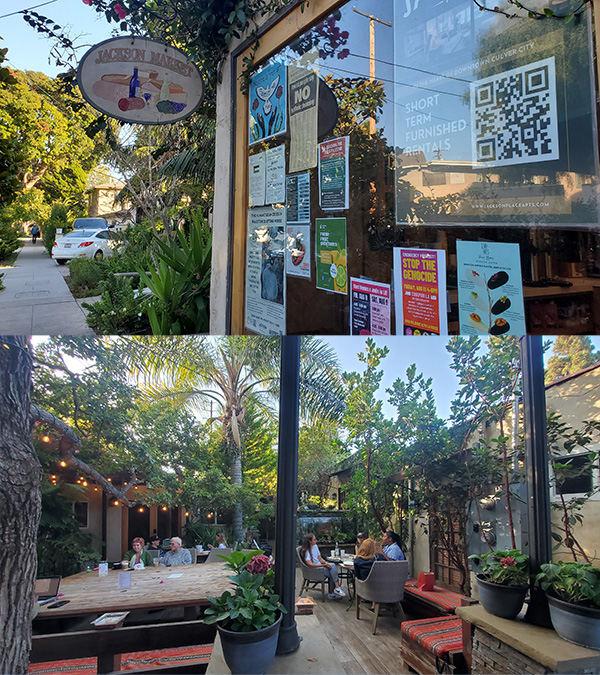
7. Jackson Market and Deli
1925
4065 Jackson Ave, Culver City
Take a short detour off of the CicLAvia route off of Culver and you’ll find a literal hidden gem nestled within Culver City’s Park East residential neighborhood. Jackson Market was originally a butcher shop founded a century ago, before zoning laws mandated that all buildings on the street be residential, and became a neighborhood market in the 1950s. In the late 1990s, the market added a sandwich deli. But the current incarnation of the market has existed since 2000, when current proprietor, Syrian immigrant Tony Iswtani built a backyard dining patio area that beckons to be not only seen but experienced. It became an instant hit with the locals, and is a popular neighborhood hang, encouraging its social “third place” function. Enjoy the deli sandwiches (the Militant enjoyed a BBQ Brisket Panini here recently), wraps, salads, breakfast items and even pizza, but leave your laptop at home: This is meant to be a dining and social venue, not a WeWork co-working space.
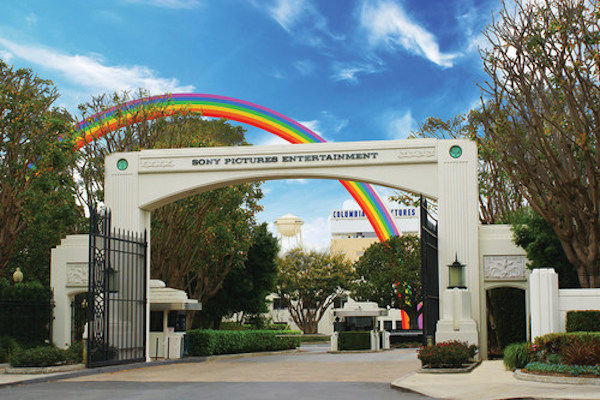
8. Sony Pictures Studios/MGM Studios
1915
10202 West Washington Boulevard, Culver City
One can’t mention Culver City without mentioning its massive movie lot, originally Thomas Ince’s (remember him?) Triangle Studios operation until he moved to the Culver Studios property and sold this site to D.W. Griffith and Mack Sennett. In 1918, the studio was sold to Samuel Goldwyn, which became Metro Goldwyn Mayer in 1924 (following the merger of Metro Pictures, Goldwyn Studios and Louis B. Mayer Productions). It became the Columbia Pictures studios in 1989 and Sony Pictures Studios from 1992 to the present.
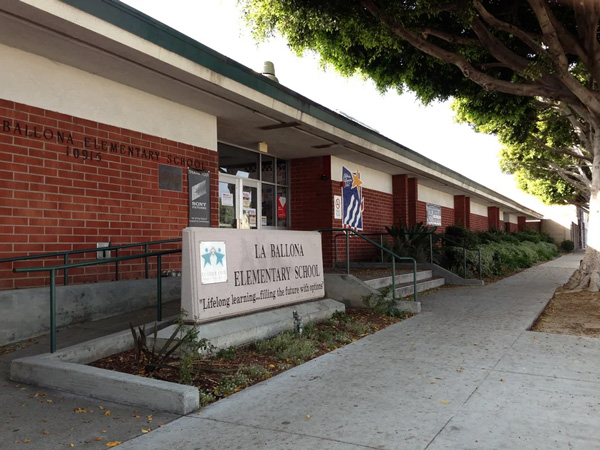
9. La Ballona Elementary School
1865
10915 W Washington Blvd, Culver City
This local school is literally some old school Culver City right heah! Established in 1865, it’s one of the oldest schools in Los Angeles County still in operation. Back in the day, it had an enrollment of 158 pupils between the ages of 5-15, being taught by one teacher, a Miss Craft who made $50 a month, and the school year lasted seven months, since it revolved around the agricultural calendar of the surrounding area. When it was established, it was in an unincorporated area that eventually became Palms, which was annexed to the City of Los Angeles in 1914. When Culver City was founded the year before, it had no schools within its boundaries, so another school was built in the area in 1916. Eventually La Ballona was annexed into Culver City in 1920.
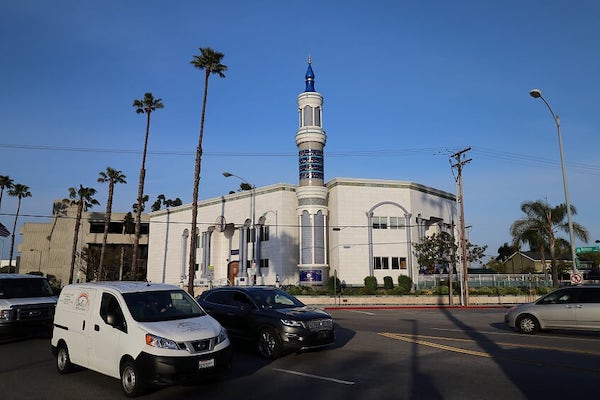
10. King Fahad Mosque
1995
10980 Washington Boulevard, Culver City
This Islamic house of worship was built in 1995 as a gift from Saudi Prince Abdulaziz bin Fahad to serve the growing community of Muslims in the Westside, named after the king of Saudi Arabia at the time. Its facade features hand made marble tiles from Turkey, and a 72 foot-high minaret topped with a gold leaf crescent.
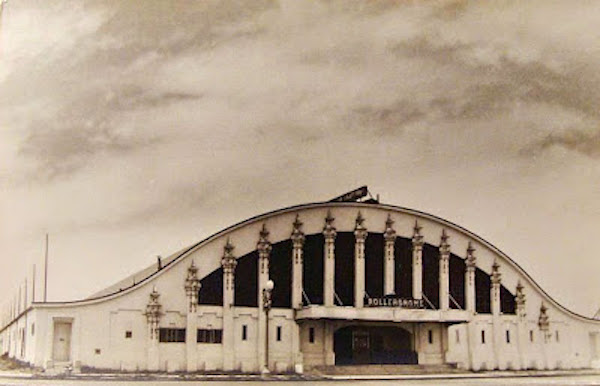
11. Tellefson Park/Site of The Rollerdrome
1976/1928
1105 W. Washington Pl, Culver City
There’s a designated activity hub here at this 1.5-acre Culver City park, which was dedicated in 1976 as part of the U.S. Bicentennial celebrations. It was named after former Culver City councilman and city attorney Mike Tellefson, who served the city for 31 years. In 2013, the body of a suicide victim was discovered in the park.
But longtime Culver Citizens remember this site as a legendary roller skating rink called The Rollerdrome, a wooden structure which opened in 1928 and had a characteristic rounded roof. Roller skating events were centered around the rink’s organ, which was played by a live organist, and provided memorable evenings for local families and youths. It was torn down in 1970, which was a shame, since roller skating enjoyed a renaissance of sorts in the ’70s.
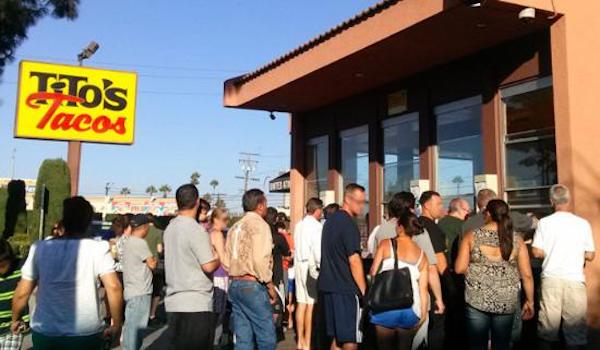
12. Tito’s Tacos
1959
11222 Washington Pl, Culver City
Many Angelenos already know of this longtime Westside (American) taco joint known as Tito’s Tacos, which as we all know, was founded in 1959 by a businessman who may or may not be an actual Mexican guy named Tito. Everyone has their opinion on Tito’s, but three things are indisputable truths: 1) It’s a Culver City Institution; 2) It’s not authentic Mexican food and 3) People come here for the nostalgia anyway. During the “Culver City Meets Venice” CicLAvia in August 2015, a minor controversy erupted when the restaurant’s owner threatened to sue Culver City government for potential lost revenue due to the CicLAvia route (what else can you do?), and everyone, including The Militant got all in on that, but ultimately, cooler heads prevailed, and after an intervention by the CicLAvia organization, Tito’s Tacos warmed up to the route, and likely did a 180 once crowds queued up along their sidewalk service windows. Titogate 2015 was now history. The moral of the story? Never fear CicLAvia, and a little communication and understanding goes a long way.
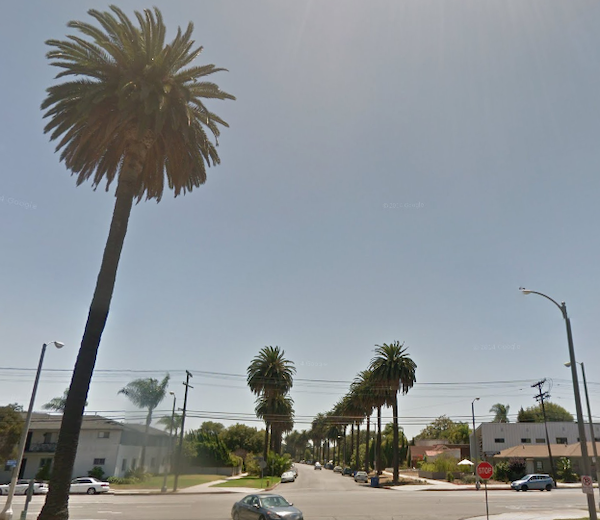
13. The Oval District/Palm Place
1912
Area within Washington Place, McLaughlin Ave, Venice Blvd & Inglewood Blvd, Mar Vista
You might not see much from the street level, but this neighborhood just south of the CicLAvia route, a Historic Preservation Overlay Zone known as “The Oval District,” is one of the first automobile-oriented property tract developments in Southern California. When seen from a map or an aerial view. the streets of this 200-unit housing development of predominantly 1- and 2-story homes resembles an hourglass shape with an oval road in the center (which caught The Militant’s eye and caused him to investigate the history of the place). The 137-acre neighborhood was developed in 1912 by a Lillian Charnock Price (there is a “Charnock Road” two blocks north of Venice, BTW) who hired renowned landscape architect and urban planner Wilber David Cook, Jr. (who worked for legendary late 19th/early20th-century landscape architect Frederick Law Olmsted to design an “Aristocratic Suburb” marketed as “Palm Place”). The large-sized lots were unique, and park-like in their large setback from the street and the palm tree-lined parkways, but only a small number of homes were built. Price sold the development to Robert Sheman, who was the stepson of Moses Sherman, the developer of the Los Angeles and Pacific Railway, which built the original rail line on nearby Venice Boulevard. What was originally intended to be the first car-oriented development was going to be a transit-oriented development! But those didn’t sell either. The lots were still too large and pricey. So Sherman sold it to a financier group that marketed it as “Marshall Manor” in 1920 and interest began to pick up. But it wasn’t until after World War II, when suburbanization was in vogue and Los Angeles’ Westside development boom commenced, that the rest of the lots got built.
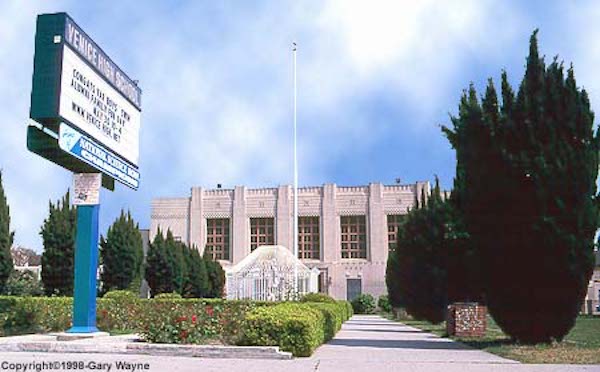
14. Venice High School
1920
13000 Venice Blvd, Venice
Venice’s namesake secondary school was one of three on-location sites for Rydell High in the 1978 motion picture Grease, and was the school scene in the Britney Spears video for her debut hit, “…Baby One More Time.” The main Moderne-style school buildings, built in 1935-37 were designed by local architects John C. Austin and Frederick M. Ashley, who also designed the Griffith Observatory. The campus is also famous for its statue of legendary Hollywood actress and famous alumna Myrna Loy at the front of the school. Other famous alumni include Beau Bridges, Crispin Glover, the late Ivory Queen of Soul, Teena Marie and In-N-Out Burger founder Harry Snyder. Go Gondoliers!
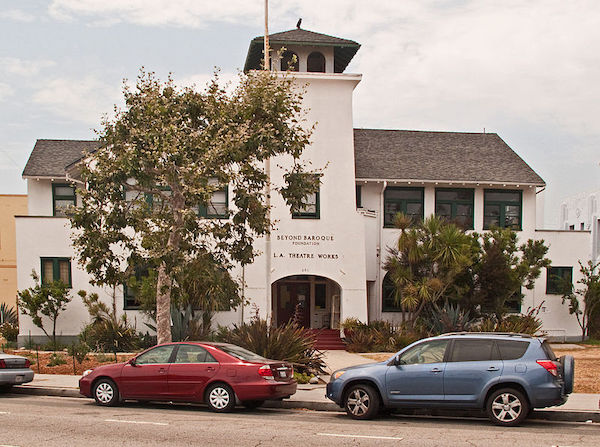
15. Old Venice Civic Center
1911
681-685 Venice Blvd, Venice
Venice, originally founded as part of Santa Monica, seceded from that city in 1911 and for the next 15 years, functioned as an incorporated city. In 1926, due to political mismanagement and crumbling infrastructure, it was annexed into the City of Los Angeles. Its vestigial remnants of its civic government still remain, though. The old Venice City Hall still stands at 685 Venice Blvd (pictured), now the venue for Beyond Baroque Theatre. Next door on 681 Venice Blvd is the old Venice Police Station, now the home of the Social Public Arts Resource Center (SPARC), the community arts nonprofit that spearheaded the modern urban mural movement. It’s interesting to note that both of these government buildings were adaptively re-used for arts purposes. The Militant is looking at the old LAPD Parker Center in DTLA and wonders if it could make some sort of badass performing arts venue…
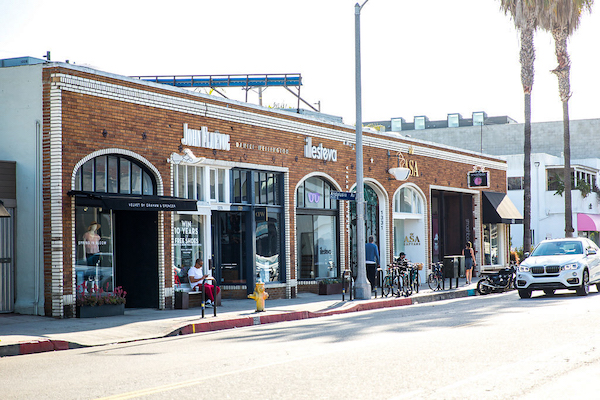
16. Abbot Kinney Blvd
1992
Abbot Kinney Blvd between Washington Blvd and Main Street
New arrivals to Los Angeles are likely oblivious to the fact that Venice’s upscale arts and boutique corridor is technically one of its newest streets. Until 1992, that stretch was confusingly known as West Washington Blvd, which, along with Washington Street and Washington Way, was a source of disorientation among motorists. A small group of business owners lobbied to re-name the stretch after the community’s founder. Ignorance of local history was so bad back then, that then-City Councilman Zev Yaroslavsky, who grew up in the Westside, asked aloud at a Los Angeles City Council committee meeting, “Who is Abbot Kinney?” (Really, Zev?!?!) Thankfully, due to a street name change, and other things, we’re a lot better at our Los Angeles history.
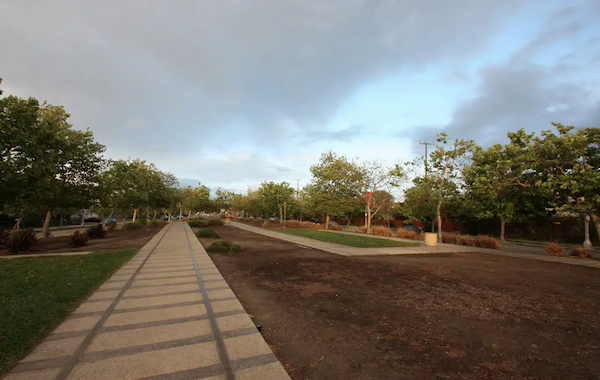
17. Venice Of America Centennial Park
2005
Venice & Abbot Kinney boulevards
This park, which neighbors the Venice-Abbot Kinney Memorial Branch Library and built for Venice’s centennial year of 2005, was made on the very same median that carried the Pacific Electric Railway tracks, and in honor of that, the design on the park’s paving resembles that of railroad tracks. The Militant went there in a famous bike ride to Venice Beach in 2008 and encountered a bunch of ducks walking in this park.
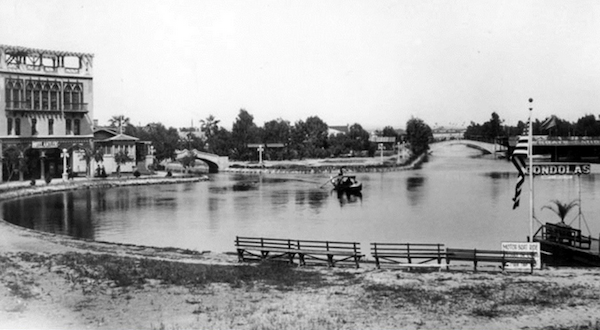
18. Windward Circle and the Lost Canals
1929
Grand and Windward avenues, Venice
Traffic circles, or “roundabouts” as they’re known in Britain, are not a common sight in the US, much less Los Angeles, though a dozen or so are known to exist here (more in a future post). So what up with this one? This part of Venice was part of Abbot Kinney’s original “Venice of America,” replete with its own canals. But unlike their Italian counterpart, these canals were not physically connected to the ocean, and the water had gone stagnant and kinda gross. By the 1920s, the Venice city infrastructure was falling apart (which meant little resources or political will to maintain the canals), and the automobile had started to conquer the streets of the Southland. So they were filled in circa 1929. The CicLAvia course on Grand Boulevard was once the Grand Canal, and the traffic circle was formerly the location of a large saltwater swimming lagoon. The surviving canals, located south of Venice Blvd, were built by a different developer a couple years after Kinney’s canals opened. Speaking of canals, an authentic former Venice of America gondola is on public display on the east end of Windward Circle.
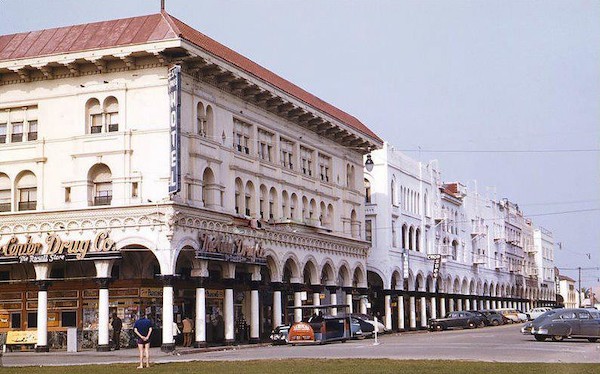
19. Windward Hotel/Pacific Electric Station
1905
Windward and Pacific avenues, Venice
The Windward Hotel, now a traveler’s hostel, is not only the oldest hotel building in Venice, but its eastern ground floor entrance also functioned as Venice’s Pacific Electric station. For the first half of the 20th Century, Venice was a popular western destination for the Red Cars, and the preferred way to go. North of Windward Way, there was no Pacific Avenue, but a dedicated “Trolleyway” for the Red Cars. When passengers disembarked at the Venice station before 1929, they were treated to an awe-inspiring view of the large lagoon (now the traffic circle) and canals just across the street, welcoming them to Venice of America. Now, for CicLAvia, when you arrive here, use your imagination and pretend to be transported back to a time when you didn’t need cars to get around. On this day, it won’t be that hard.
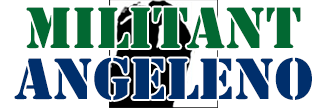
You must be logged in to post a comment.